Stunning Stepwells of Gujarat, India - What is so special about these ancient Multi-story water-tanks with beautiful carvings & wonderful architecture
Gujarat state of India has approximately 100 stepwells in different parts of this state. Stepwell is also called vav which is a hindi word. The vavs are traditional & ancient water harvesting systems which were built many years ago to deal with water related challenges and now they are beautiful heritage sights. Some of the stepwells still have water in them, although there are very few which are actually being used for water now. Many of these vavs have incredible architecture with some fantastic carvings & designs on walls/pillars. That's the reason that many of the folks still visit these sites to explore. Many of them are supported by Archeological Survey of India and Rani no Vav in Patan is UNESCO heritage site.
Let's know about some of the most popular stepwells of Gujarat.
Rani ki Vav, Patan - Largest Stepwell & A UNESCO's World Heritage Site in Gujrat :
Rani Ki Vav is popularly known as largest stepwell in Gujrat state of India. Rani ki Vav is a stepwell situated in the town of Patan in Gujarat state of India, which is located on the banks of Saraswati river. This stepwell was rediscovered in 1940s and restored in 1980s by the Archaeological Survey of India. It has been listed as one of UNESCO's World Heritage Sites since 2014.
Rani ki vav of Patan is considered as the finest and one of the largest example of stepwell architecture in Gujarat. The architecture and sculptures is similar to the Vimalavasahi temple on Mount Abu and Sun temple at Modhera.
Timings of Rani ki Vav are from 8:30am till 7pm everyday with some holidays which should be checked on official website before planning your visit. The place is maintained by Archeological Survey of India and their website would list latest details around timings and ticket pricing.
There is an entry ticket for Rani ki Vav in Patan town of Gujrat. Entry fee is 40 INR for indians and 600 INR for foreigners.
If you are in Ahmedabad and have few days to explore places around this part of Gujrat, it makes sense to plan a day tour to Patan to witness these wonderful stepwell called Rani Ki Vav, which is also a UNESCO's World Heritage site.
After getting the ticket, you have to walk for 2-3 mins around well maintained lush green lawns and then there is a space from where you have to just follow the stairs to get down to the stepwell and appreciate it's grandness & beauty.
There are authorised guides available at Rani ki Vav in case you are interested in knowing about the history associated and some interesting facts, which can be appreciated in much better way when you are there.
The stepwell is divided into seven levels of stairs which lead down to deep circular well. A stepped corridor is compartmentalized at regular intervals with pillared multistory pavilions. The walls, pillars, columns, brackets and beams are ornamented with carvings and scroll work. The niches in the side walls are ornamented with beautiful and delicate figures and sculptures. There are 212 pillars in the stepwell.
Rani Ki Vav in Patan town of Gujrat is a finest and one of the largest example of its kind and designed as an inverted temple has seven levels of stairs with sculptural panels, more than 500 principle sculptures and over a thousand minor ones combine religious, mythological and secular imagery.
The closer you look into the carving and correlate it with when these carvings were made, it makes you appreciate this beauty even better. If you are able to imagine, now try to think about the size of the space and the amount of carvings it has. It's truly mind blowing and amazing to think how much efforts were put in build a water tank.
Above photograph is clicked from 3rd floor of the stepwell, which means 4 more levels to go down and explore the stepwell. Stepwell is closed beyond 5th level. Visitors are not allowed to go beyond 5th level of the stepwell, but there is a spot to view some of the details of other levels. The last level is magnificent but truly visible when you look at it from other top with wooden boundary. We shall talk about that soon in this post.
As you go down, the depth of the stepwell increases but the grandeur keeps on surprising you after each step you take downwards. Above photograph is probably clicked from 4th level of stepwell from top and here you see only the top parts of different levels in layered manner. the extreme end of the photograph shows top of the core level (7th level of Rani ki Vav). This section is closed so you can't explore that well. It's mainly for restoration and ensuring that it's preserved well. Hope that ASI figure out a way to open this section for visitors in a way that things don't get damaged in that process.
In above photograph, notice 2 folks on the top looking down at Rani ki Vav in Patan and the view from there is mind blowing. Next photograph is clicked from the same spot. If you are there and trying to have this view, don't climb up the boundary and better use your cameras to witness the view through digital advancements.
Rani Ki Vav is classified as a Nanda-type stepwell. It measures approximately 65 metres long, 20 metres wide and 28 metres deep. The entrance is located in the east while the well is located at the westernmost end and consists of a shaft 10 metres in diameter and 30 metres deep.
It is worth to hire a guide to know. You can negotiate with guide to pay 200-400 rupees for one hour. You will have to walk for almost one kilometer inside.
Above photograph shows a special view of the core of the stepwell. There is a walking trail at the top this stepwell which revolves around the boundary of the stepwell. This photograph doesn't show the real depth which was hard to capture well, given how this walking trail is built. and this photograph shows 3 levels from core of Rani ki Vav in Patan, Gujrat.
Unfortunately Rani ki Vav, which is such great architectural monument is not that well known in India. How could the size of stone underground was estimated 800 years ago without modern technology is hard to imagine. Then the entire complex underground being carved from top to bottom with sculptures and layers of stone pillars makes this monument very unique. Certainly worth visiting while in this part of Gujrat state in India.
There is very good landscaping done around Rani ki Vav and we noticed some groups doing picnic around the shade of these huge trees planted in the complex. I love this part that ASI pays equal attention to landscaping and keeping the place green apart preserving the history.
Overall we loved our visit to Rani ki Vav in Patan and then headed back to Gandhinagar to spend some time around the famous Akshamrdham.
Wankaner Palace Stepwell :
The Wankaner Palace is a good example of how well a heritage structure can be preserved. Now it's known as Royal Oasis Hotel, in form a heritage hotel. The palace has early 20th century stepwell. This stepwell is still in our bucket list and that's why you don't see any photograph of Wankaner Palace Stepwell.
To our surprise, not lot of people prefer to visit Modhera Sun Temple from Ahmedabad and after visiting, I would say must do one day trip from Ahmedabad should be Modhera Sun Temple, Rani ki Vav in Patan and Adalaj ni Vav.
Modhera Sun Temple & Modhera Surya Kund opens at 7am everyday and closes at 6pm.
The Modhera Dance Festival which is also known as Uttarardh Mahotsavor Modhera Utsavis and is one of the most famous celebration of art, music, dance and culture, in Gujrat state of India. This unique occurrence showcases traditional dance forms of the region as well as acts as a platform bringing together the cultural ethos of other regions expressed in form of dance.
Entry fees for Modhera Sun Temple & Modhera Surya Kund is 20 rs per person. There are no extra charges for camera. Modhera Sun Temple & the stepwell are maintained by Archeological Survey of India and as usual they do a pretty good job in maintaining the place. Ticket counter is manned by ASI employees, who are usually pretty knowledgeable, so feel free to talk to them and ask if you have any questions.
The Sun temple complex in Modhera is built in Chaulukya style. The temple complex has three components - the shrine garbhagriha in a hall called gudhamandapa, the outer assembly hall sabhamandapa and a sacred reservoir with water in it. Above photograph shows Sabhamandapa on the top and water reservoir in the front. Gudhamandapa is in the back side of the temple you see on the top.
We sat around this water reservoir for a long time, before we saw the main temple on the top. I walked around all four walls of this stepwell at Modhera Sun Temple. It was pretty hot in the month of October, so we took some small breaks around shade.
Above photograph is clicked from main Sun Temple facing towards the water reservoir. If you notice the background of photograph above, there is plenty of trees around well maintained & lush green lawns. These are brilliant spots to sit around & enjoy the beauty of Modhera Sun Temples in Gujrat.
Symmetry across Modhera Surya Kund is very tempting and that's why you see so many photographs in this Photo Journey showing series of pillars or carvings leading to one another.
Travellingcamera loved clicking these shadows of Modhera Surya Kund in Gujarat.
Modhera Sun Temple is very well maintained, with a short walk through gardens leading to the stepwell behind which lies the main temple. Being an ASI site, official guides are available and you can chose to have a guide with you who help understanding history & how this space evolved over the centuries.
If you are planning to visit Modhera Sun Temple & Modhera Surya Kund, plan to go earlier in the morning to beat the worst of the sun.
Pleasant landscaping around the complex adds to the heritage look. Above photograph shows the first view of the temple you get while walking into the temple complex from ticket counter.
Modhera Sun Temple & Modhera Surya Kund (Stepwell) was best place from our day trip from Ahmedabad and we highly recommend planning a visit to Modhera to see this magical Sun Temple of Gujrat.
... ...
Adi Kadi Vav and Navghan Kuvo in Junagarh :
Junagadh has 2 stepwells - Adi Kadi Vav and the Navghan Kuvo. And the interesting part of these is that they are cut out from rocks.
The Navghan Kuvo is approximately 1000 years old and the Adi Kadi Vav was built in the 15th century. Junagadh is 330 km away from Ahmedabad.
....
Adalaj Ni Vav is a stepwell located in the village of Adalaj, close to Ahmedabad city and in Gandhinagar district of Gujarat state in India. Adalaj ni Vav was built in 1498 in the memory of Rana Veer Singh by his wife Queen Rudadevi. It is a fine example of Indian architecture work and a fantastic attraction for tourists visiting this part of Gujrat.
There is an entry ticket fees at Adalaj ni Vav. Above photograph shows the ticket counter which is maintained by Archeological Survey of India. Entry Fees for Adalaj ni Vav is 25 rupees per person and no extra charges for cameras. The Entry fees is different for foreigner tourists.
Adalaj village has a temple which is just in front of main road and there is a small road going in parallel to the temple. One needs to take that road as the entry gate is on back side of this temple in Adalaj. There is decent parking place for 5-6 vehicles in front of entry gate of Adalaj ni Vav. If you don't find enough parking space, there is huge space around the road and in front of the temple to park your vehicle. Parking is free.
Above photograph shows the view from bottom of the stepwell at it's core. You can see circular structure which is exactly at the core where water body used to be there. It's dry as of today, but this is the spot where water used to be there. You can make out that Adalaj Stepwell has 5 levels. The architecture is beautiful at each level and there are plenty of things worth observing and debating. We didn't have any guide at Adalaj ni Vav and we sort of missed that.
The Adalaj step-well is a popular tourist attraction of the Gandhinagar city and is situated approximately 18 kilometres from Ahmedabad city of Gujrat. Adalaj ni Vav is 5 kilometres from Gandhinagar, the capital city of Gujarat.
Ahmedabad is well connected by road, rail and air links with the rest of the country. The international airport at Ahmedabad, known as the Sardar Vallabhbhai Patel Airport, has flights operating to several countries. Gandhinagar is the railway station closest to the stepwell. We visited Adalaj ni Vav from Ahmedabad city of Gujarat.
Here is a photograph clicked from 3rd level of Adalaj ni Vav. This is a photograph of roof which you see after getting down to 3rd level of the stepwell. Each level has some beautiful structures around pillar, roof & floor.
Above photograph shows a small carving design on a wall, which is looking like a jharokha which has lost some of it's elements. Although ASI is maintaining this beautiful Stepwell but it seems some damage is still happening at this space.
The motifs of flowers and graphics of Islamic architecture blend very well with the symbols of Hindu and Jain gods carved at various levels of the well. The dominant carvings on the upper floors are of elephants. The Islamic architectural style could be attributed to the Muslim king Begda who built it. The walls are carved with women performing daily chores such as churning of buttermilk, adorning themselves, scenes of performance of dancers and musicians, and the King overlooking all these activities.
Above photograph shows blue sky of Gujrat through roof-top of 2nd level at Adalaj ni Vav. I loved clicking some of these photographs with my phone camera at Adalaj ni Vav. The whole structure looks awesome and every level of the stepwell is unique. The deep you go, better you appreciate the architecture and the grandness of these stepwells.
A tribute paid to the rich underground structures, which are intricately decorated with sculptures, is that they are said to resemble palaces.
The sunshine on that particular day made our visit even more special. I love capturing shadows along with multiple colors showing character of the space. This photograph is clicked at top level of Adalaj ni Vav in Gandhinagar district of Gujrat.
Above photograph shows roof-top of the Stepwell in Adalaj village of Gujrat. Tourists are allowed to access this area but it's important to be careful as some of the levels don't have cover on the top, while some of the levels have iron nets covering their tops. Above photograph also shows nearby temple at Adalaj.
The temperature inside the stepwell of Adalaj is said to be about five degrees lower than the outside hot summer temperatures. This encouraged the women who came to fetch water to spend more time in the cool climes here. They stayed to worship the gods and goddesses and gossip.
Above photograph shows just the entry of Stewell rooftop with green lawn in the background. Step wells like the one in Adalaj were once integral to the semi-arid regions of Gujarat, as they provided water for drinking, washing and bathing. These wells were also venues for colourful festivals and sacred rituals.
Navlakhi Vav in Vadodara :
The beautiful Laxmi Vilas Palace has 15th century Navlakhi Vav. Navlakhi was built by spending nine lakh gold coins. This Stepwell is still in use for irrigation of the golf course next to it. We couldn't see the palace and vav when we were in Vadodara, as palace compound was closed. So whenever you plan a visit, know before hand about opening timings/days of Laxmi Vilas Palace in Vadodara.
Dada Harir Vav is little away from hustle bustle of the town but still approachable. Let's talk about how to reach Dada Harir Vav from other parts of the Ahmedabad. Ola and Uber operate in Ahmedabad city of Gujrat which means it's a very easy option to book a cab and reach Dada Harir vav from any place. Auto-rickshaw is another convenient and cost-effective option in Ahmedabad. Auto would be cheaper than app based taxis in Ahmedabad city of Gujrat.
It was very easy for us to get an Auto-richshaw from old town of Ahemdabad, so we took auto to reach Dada Harir Vav. While we had to come back, we couldn't get an auto. Although there were few autos parked but it seems everybody wanted to have a lunch break. We booked ola and that was pretty quick & convenient option.
There is no entry ticket for Dada Harir Vav in Ahmedabad and it's maintained by Archeological Survey of India. The day we visited Dada Harir Vav, a group of art students were there at different levels of the stepwell noticing beautiful architecture of the stepwell and drawing it on their canvases. Above photograph shows one of the artists capturing beauty of Dada Harir Vav in her notebook. The red adds beautiful contrast to overall photograph.
There is a caretaker at Dada Harir Vav who doesn't mind telling you some stories about the stepwell and show the place around. If you take his time, do pay some tip as that's the small token of appreciation we can give to encourage good behaviours around us. At times, it's debatable if the person should focus on taking care of the place but if he can do both why not. We should enable such people work hard for overall good of the society.
It was drizzling when we were at Dada Harir Vav in Ahmedabad and my phone did fantastic job at clicking this beautiful effect. Please have a look at above photograph with rain drops around Dada Harir Vav. Thanks to the lighting condition which made shutter speed go slow to capture the scene well and also capture these rain-drops beautifully.
Above photograph is closed from bottom of the stepwell, and from the place closer to water tank. As you can make out, it's circular at the core and looks wonderful from bottom of the stepwell. This certainly covers 2nd floor and above and not the complete view what human eyes can see & enjoy.
Above photograph is probably clicked from 2nd level of the stepwell from bottom. Each floor is spacious and at times it's hard to guess how many floors you need to go down to see water-body.
These stepwells are deep to access ground water at that level and the architecture signifies how to preserve rainwater for longer period of time and that's why you would find different styles of stepwells in different parts of the country. All levels of the stepwell have enough light and air. That's the beauty of the architecture. Imagine that someone has to take out water at any point of the day from 5th level and natural light is only source to see water & pick it. Above photograph is showing roof-top of the core of the stepwell with light coming in.
Dada Harir Vav is a sandstone structure in Solanki architectural style and this beautiful stepwell has five levels or stories. I personally prefer to call them levels, not sure why :). The actual waterbody of the stepwell is octagonal in plan at the top, built on intricately carved large number of pillars.
Entrance of Dada Harir Vav is from the East and there are two spiral staircases in West which are near the well & very narrow. We took one of them to reach the top of the stepwell. The scary part of bats roaming around and as we entered the spiral staircase, a dozen of bats flying out. Vibha has not in favour of taking the stairs but I would convince here.
Above photograph is clicked from the top of the stepwell and you can count the levels in has along with square section in the bottom which used to contain water.
Above photograph shows the view of the stepwell at ground level as 5 levels of the vav are underground and created after excavation. This photograph shows the length of Dada Harir Vav and if you notice closely, There is one section with roof and then blank. This is done 5 times for 5 levels of the stepwell. This the reason that stepwell as light till 5th level under the ground level.
Geban Shah's Vav in Champaner :
The World Heritage Site of Champaner lies in ruins and this stepwell is also in same space. The structures exhibit a beautiful mixture of Hindu and Islamic architecture.
Apart from Geban Shah's Vav, there is another broken stepwell which is known as Helical stepwell. Champaner is about 150 km far from Ahmedabad.
Apart from listed vavs in this post, Gajarat state has lot of Vavs so whenever you are in Gujarat state of India and interested in Vavs, ask around or check google maps to locate these gems for exploration. Hopefully we will visit more and update this blogpost.

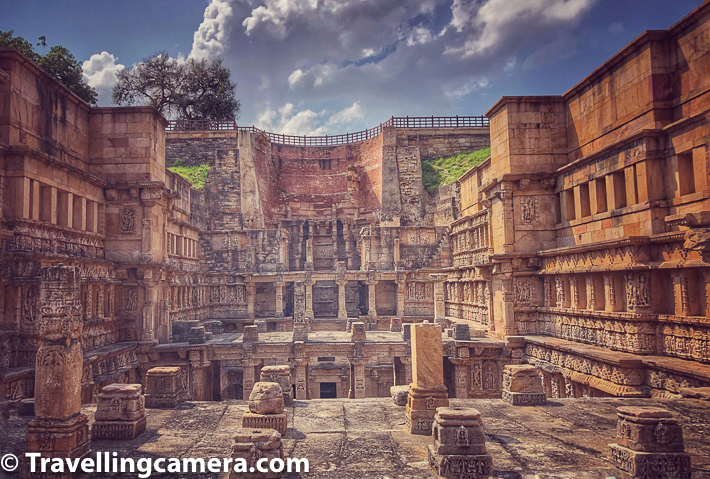
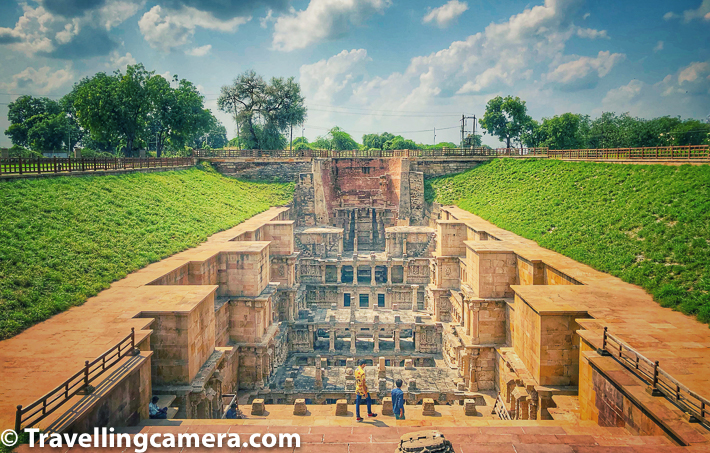

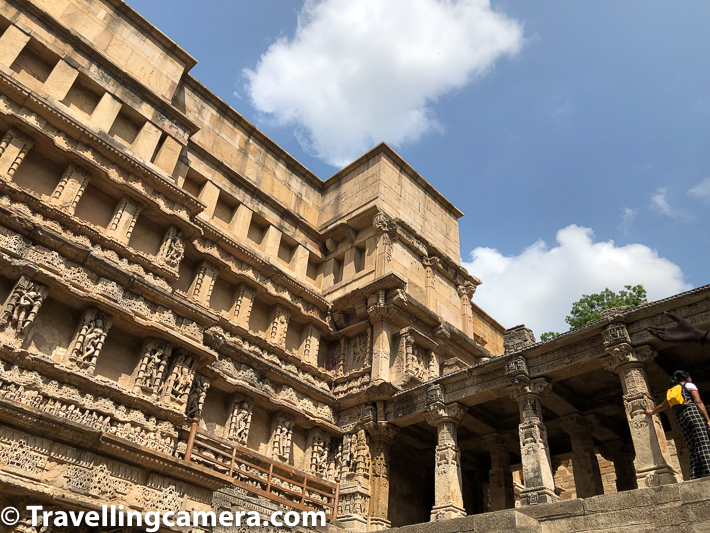








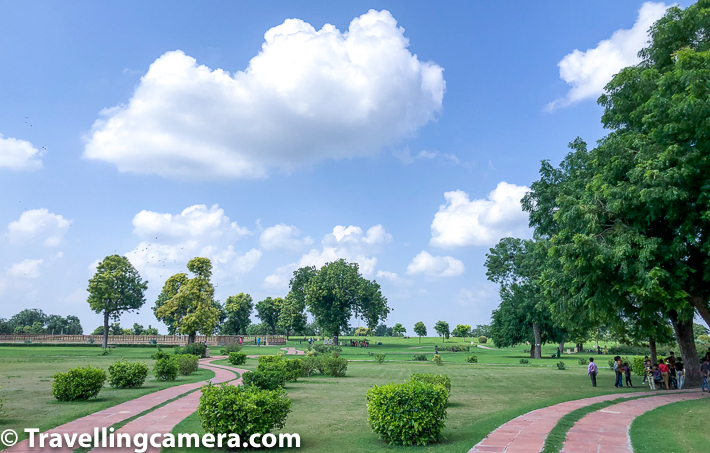

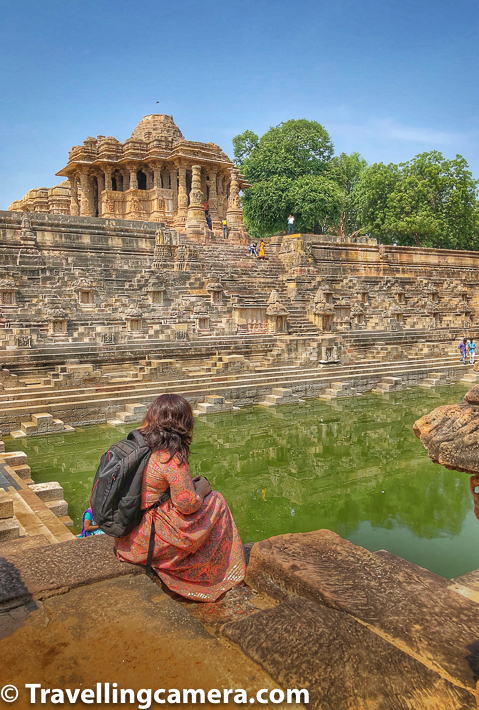





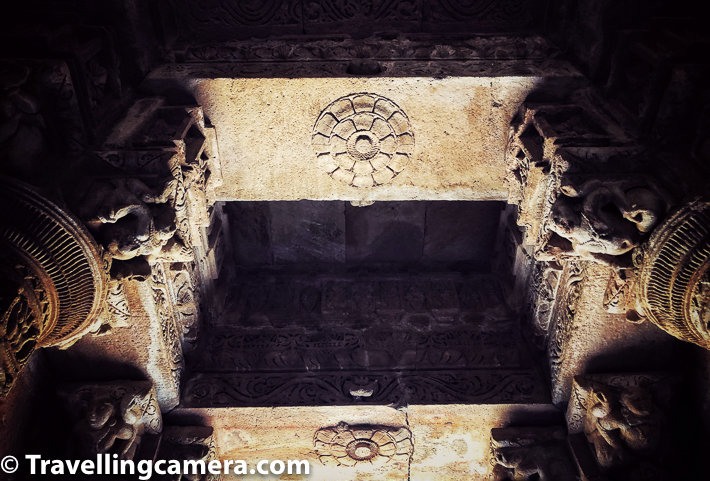

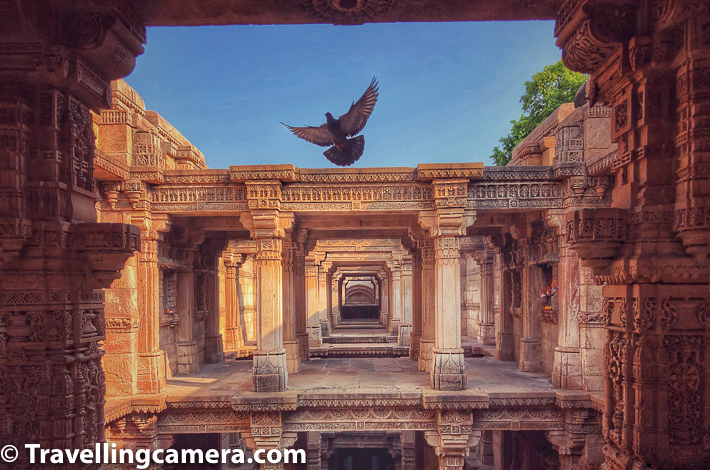


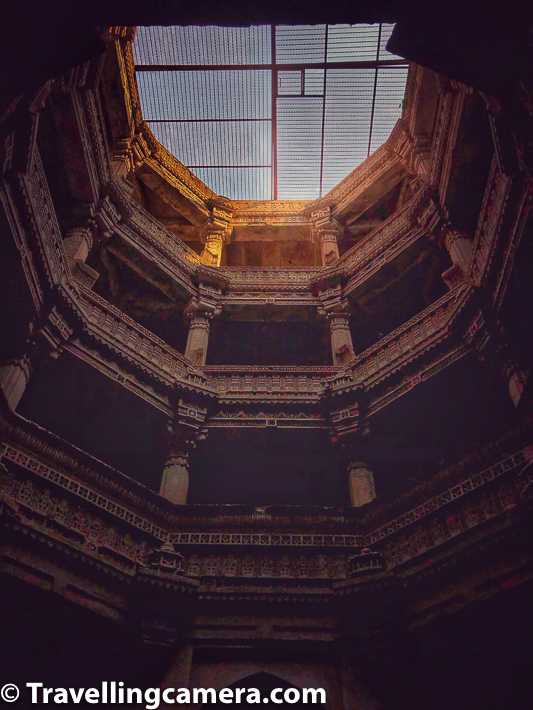





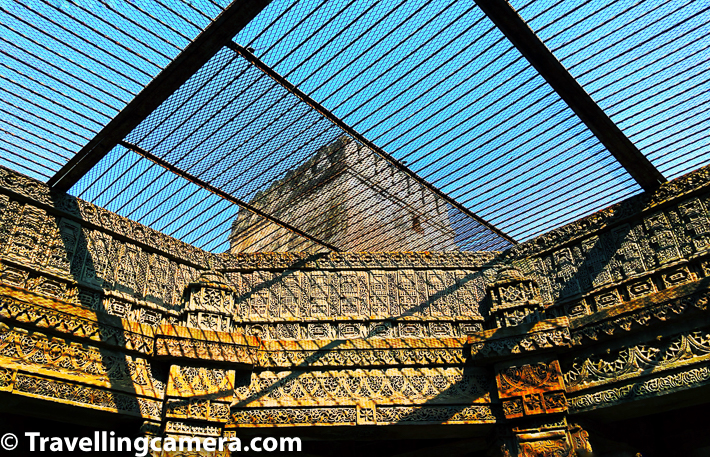



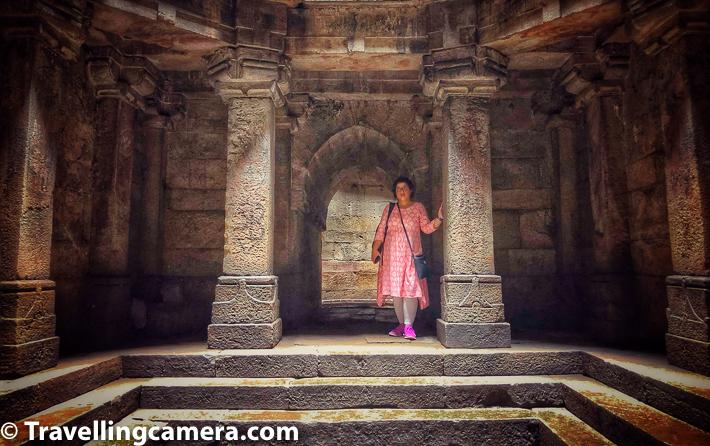












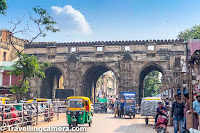

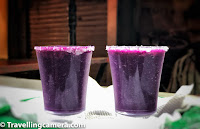
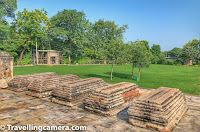
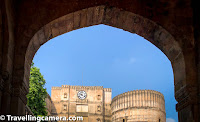
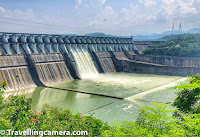


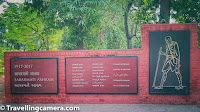
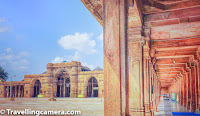

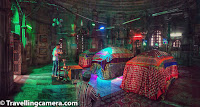

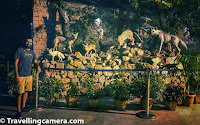

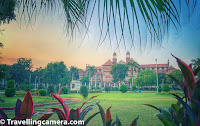
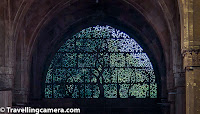
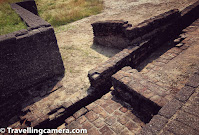

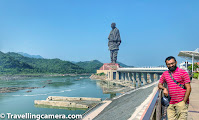

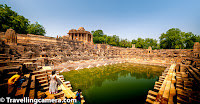

.jpg)
Comments